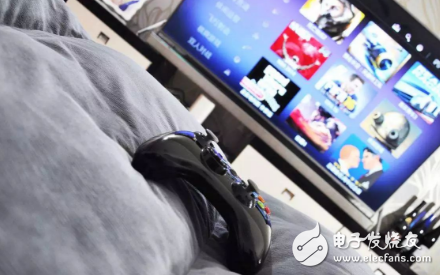
Television has long been one of the must-have appliances in the home. With the rapid development of the Internet era, the TV industry has undergone earth-shaking changes. From the passive reception of traditional cable TV programs to the current smart TV active search content, both product features and content diversity are advancing with the times. .
Smart TV is a TV product with a fully open platform and integrated functions of video, audio, entertainment and games through Internet application technology. Users can install and uninstall third-party service programs such as software and games to meet the individual needs of consumers. It has become a trend of TV. As of the end of 2017, the OTT advertising market for smart TV has reached 5 billion yuan.
Analysts of the Speedway Research Institute analyzed and discussed the development trend of the smart TV industry in 2018 by collecting and sorting out the relevant data of the Q1 domestic smart TV industry in 2018 and cooperating with user research.
Smart TV sales and growth rate
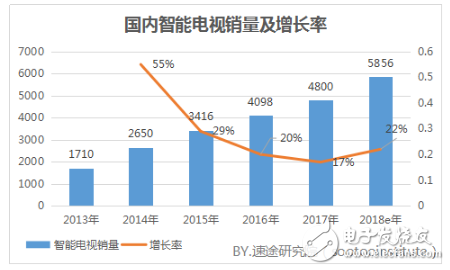
2013 can be said to be a year of smart TV explosion. Traditional TV manufacturers, Samsung, Hisense and TCL have made good progress in technological innovation and promoted the wave of smart TV development. In the same year, Internet companies Xiaomi and LeTV also entered the game and launched their smart TV brands, bringing new blood to the smart TV field. The total sales volume of smart TVs in the country was about 17.1 million units in the year. In 2014, smart TVs The market coverage has further increased, and it is also the main choice for users to purchase TV, and its sales growth rate is as high as 55%.
In 2017, the entire TV industry was limited by the large price increase of the panel, and the sales growth slowed down. The annual sales volume was about 48 million units, a year-on-year growth rate of 17%, which is also the lowest sales growth rate in recent years. However, the price of the late panel has declined. In the first quarter of 2018, there has been an oversupply situation. In addition, 2017 inventory will also be released in 2018, stimulating industry growth, pre-estimated that in 2018, smart TV sales will reach 58.56 million units.
2018 Q1 domestic smart TV market share top ten
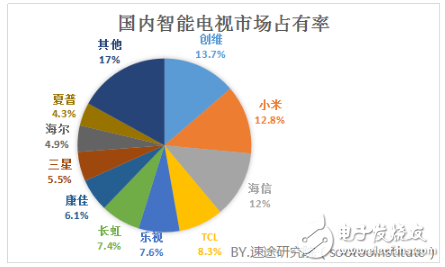
According to the survey data, in the Q1 phase of 2018, Skyworth ranked first in the industry with a 13.7% share; Xiaomi and Hisense have a hungry share of 12.8% and 12% respectively, ranking second and third in the industry. Smart TV manufacturers have increasingly invested in the market, which has intensified competition in the industry.
Display type

The screen is the core value of smart TV. Generally speaking, buying a TV is to buy a screen. Users need to consider factors such as color, sharpness, brightness, and reaction speed when selecting a screen. These are determined by the type of display. With the development of technology, the types of display screens are also being introduced. At present, the types of TV screens on the market are mainly liquid crystal displays.
LCD is a liquid crystal display, but many users are misled by advertisements, and LCDs are classified into LCDs and LEDs. To be precise, LEDs are a branch of LCDs, and LCD panels for LED liquid crystal displays are still traditional LCD displays. Corresponding to the LED is the CCFL, which is commonly referred to by the general public as the CCFL.
For liquid crystal displays, the most important ones are liquid crystal panels and backlight types. The liquid crystal panels on the market generally use TFT panels, so the difference between LED and CCFL is only the type of backlight. LED refers to the liquid crystal display with LED as backlight source. CCFL refers to a liquid crystal display using a cold cathode fluorescent tube as a backlight source.
In 2013, LG Electronics released the LG curved OLED TV for the first time at CES, marking the world's entry into the large-size OLED era. The ideal OLED technology is that OLED organic materials actively emit light, and produce RGB three primary colors to form colors. However, OLEDs currently on the market use W-OLED technology, and OLEDs only serve as self-illuminating backlights. Because in the market, W-OLED has better cost advantage and longer service life than RGB OLED, which is more suitable for market promotion.
Samsung launched QLED TV in 2017, representing the leading technology of QLED. The ideal QLED technology is the active illumination of quantum dot materials, which do not require a backlight and color filter on the display device. However, due to the immature technology, the current technology is to distribute the quantum dot film in front of the blue LED to form a higher purity backlight, which brings more "pure" color performance through the liquid crystal molecules.
Of course, both QLED and OLED represent the future development direction of real-world technology, but so far it is facing the pressure of technology and cost, because the cost determines the market price and determines the survival of the product.
Price is the most important factor for consumers
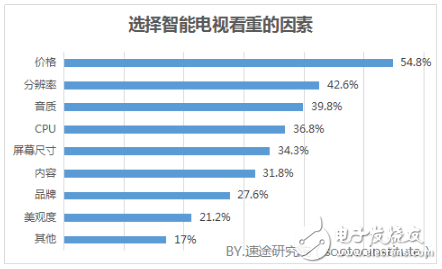
A survey of factors considered by consumers when choosing smart TVs found that prices ranked first, which is also an important reason why many new technologies have made breakthroughs in the market but have not been widely promoted in the market. Because in the fierce market competition, users value the price, the business should also consider the market and cost.
Secondly, the resolution of the image quality, the more pixels displayed on the display, the finer and clearer the picture it displays, and the wider the content displayed in the same plane area. This is also an important performance indicator for users. The resolution of a normal TV is usually 1920*1080, which is 1080p TV (that is, 2K), and the current 4K on the market refers to the pixel resolution of 3820*2160, which is 4 times that of 1080p. The resolution of 8K Ultra HD is 7680*4320. In 2017, HP took the lead in launching the 8K Ultra HD screen, which is also a symbol of HP's high-end brand. At the same time, 8K is also the industry trend of new technology in 2018.
Usually the resolution is related to the size of the TV screen, and it is also affected by factors such as the video tube distance and video bandwidth. The size of the selection screen is determined by the size of the living room space, that is, the actual viewing distance. The distance is too close to cause visual fatigue, and the too far picture is easy to be distorted, so the scientific viewing distance is 1.5 to 2 times that of the diagonal of the TV. Among the respondents, the screen size occupied 34.3%.
From the survey results, it can be found that the brand of the merchant is not the most fancy factor of the user. Most of the consumers will follow the trend. Which brand is new and the effect is good, which brand is chosen, which is caused by the intensified competition in the TV industry. the result of.
Smart TV hardware and features
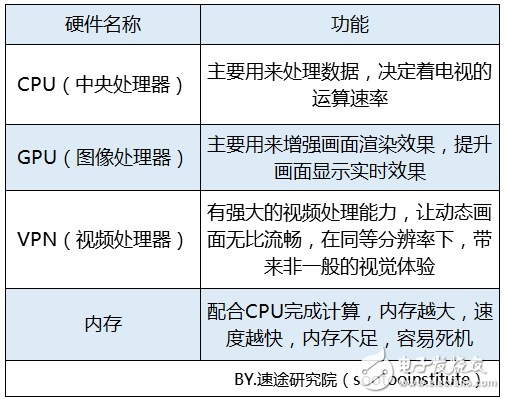
The CPU is mainly used to process data, which determines the computing speed of the TV. Among the respondents, the CPU is 36.8%, but most consumers do not fully understand the CPU of the TV. At the time of purchase, they are mainly controlled by the purchaser. Guidelines.
Video has the longest duration of use

In the first quarter of 2018, during the use of smart TV applications, video still dominated, with an average of 756 minutes of use; since smart TV can install and uninstall various games, there are more people playing games on TV. However, the majority of young people, the average duration of use is 135 minutes, and the proportion of this time is rising; the average length of online training education and other life services through smart TV is lower.
Analysts of the Speedway Research Institute believe that: In 2017, driven by the wave of artificial intelligence, smart TV entered the fast lane of optimization and upgrade, that is, entered the stage of artificial intelligence TV. The user releases the command by voice, and after receiving the voice recognition command, the television can jump and present the content in any scene, and also brings a revolutionary breakthrough for the television industry. In the future, the artificial intelligence-enabled TV industry is not only a tool for audio-visual entertainment in the home, but also an interactive platform that combines multi-function and large-screen. With the development of technology, artificial intelligence TV will become the center of family intelligence.
19MM Metal Switches
19MM Metal Switches, also known as Metal Push Button Switch in harsh working environment. The most competitive advantage of this Metal Switches is that it is high mechanical life, in which momentary could reach 1,000,000 cycles and self lock is 500,000 cycles. Stainless steel is resistant to damage IK10, it is very hard and reliable. Therefore, this series of metal switch is widely used in automobiles, ships, medical and large mechanical equipment.
In order to ensure the trust of our customers, this series Push On Push Off Switch has passed UL testing and certification, IP67 dust-proof and waterproof certification, TUV, European and American environmental protection RoHS and lead-free environmental protection certification .
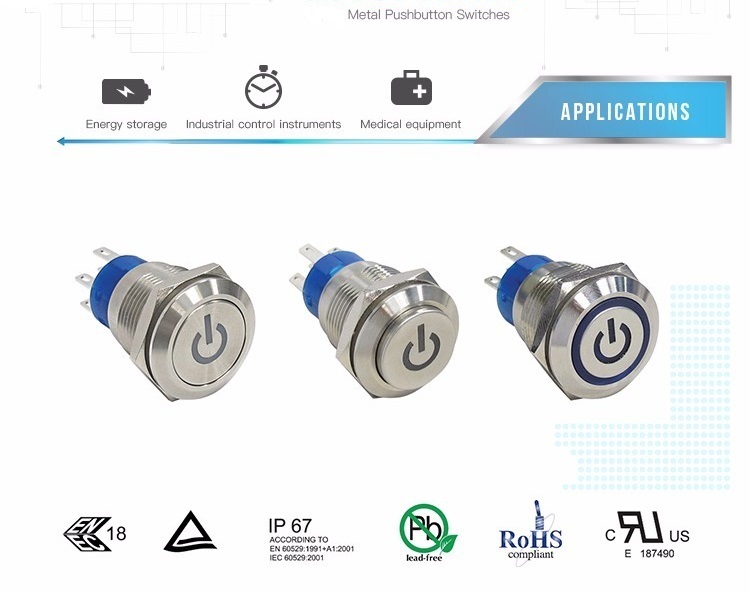
Our 19mm Waterproof Push Button Switch have a variety of materials, including stainless, brass with nickel plated, brass with chrome plated, AI alloy with black anodized. This serious Push On Push Off Switch could offer different LED light, including white, red, yellow, green. Customer can select power logo indicator when controlling the power supply, customers could choose the double color indicator light when Switching different function.
Furthermore, all the LED indicate light are provided by well-known LED lamp manufacturers, guarantying the long-term use of LED lights and high-life mechanical life

19Mm Metal Switches,Metal Push Button Light Switch,Metal Ss 19Mm Switch ,Metal Led Light Push Button Switch
YESWITCH ELECTRONICS CO., LTD. , https://www.yeswitches.com
